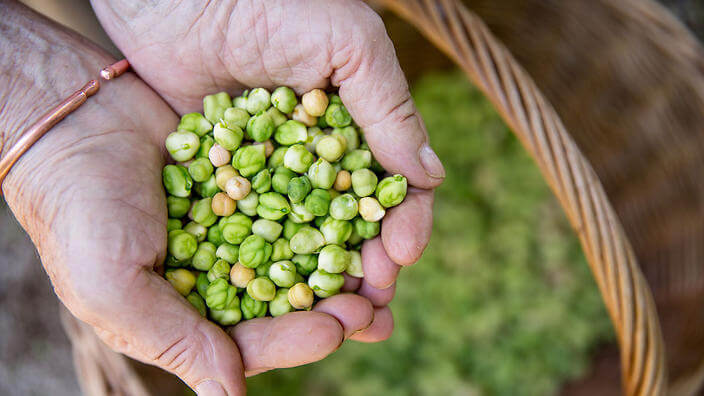Chickpeas are a staple of many plant-based diets, but fava beans are a great way to introduce some variety if you need something a bit different.
I’ve created a short head-to-head comparison of fava beans and chickpeas so that you can decide which one is more important for your specific diet.
Table of Contents
Taste of Fava Beans vs Chickpeas
Both of these legumes have a unique taste, although fava beans have more of a distinct flavor than chickpeas:
- Fava beans – Also known as the “broad bean,” fava beans have a slightly firm, but creamy and nutty flavor. They typically are used in salad and soup recipes.
- Chickpeas (garbanzo bean) – Perhaps the most versatile bean. With a mild beany flavor, chickpeas go well in a wide variety of meals, from salads to curries. These beans are neither hard or soft, they’re somewhere in the middle.
Can I Use Fava Beans Instead of Chickpeas?

In terms of bean flavor, both of these are on the mild side, which is why many recipes interchange fava beans with chickpeas.
For example, there are many falafel recipes that use either one.
In any soup or salad recipe, it’s fine to substitute chickpeas for fava beans or versa if you like the taste of one better. However, in other recipes like desserts, you should not substitute fava beans for chickpeas.
Nutritional Value Comparison
While both beans share a lot of the same nutritional value, there are some differences.
The data below is all per 100 grams (a bit over 1/2 cup) of cooked bean.
Macronutrients
Let’s start by looking at the main macronutrient profiles of chickpeas and fava beans:
| Fava beans | Chickpeas | |
|---|---|---|
| Energy (kcal) | 110.0 | 164.0 |
| Protein (g) | 7.6 | 8.9 |
| Total Lipid (g) | 0.4 | 2.6 |
| Carbohydrate (g) | 19.6 | 27.4 |
| Fiber (g) | 5.4 | 7.6 |
| Sugars (g) | 1.8 | 4.8 |
A few things stand out:
- Chickpeas have way more calories, protein, fat, and carbohydrates
- The relative proportion of protein to calories is higher in fava beans
Many people on a plant-based diet struggle with getting enough calories, so chickpeas would be a better choice for those people.
On the other hand, vegan athletes often struggle with getting enough protein without too many excess calories, so eating more fava beans would be the better option.
Vitamins and Minerals
Now let’s move on to the other nutrients. Both beans have a ton of nutritional value and are very healthy.
The RDA column in the table below is just intended for a reference and to help order the nutrients. The specific RDA for your age and gender will likely be a bit different.
| RDA | Fava Beans | Chickpeas | |
|---|---|---|---|
| Manganese (mg) | 2.3 | 0.4 | 1.0 |
| Folate (µg) | 400 | 104.1 | 172.0 |
| Phosphorus (mg) | 700 | 124.7 | 168.3 |
| Iron (mg) | 18 | 1.5 | 2.9 |
| Potassium (mg) | 2000 | 268.2 | 290.9 |
| Zinc (mg) | 11 | 1.0 | 1.5 |
| Magnesium (mg) | 400 | 42.9 | 48.2 |
| Vitamin B-6 (mg) | 1.3 | 0.1 | 0.1 |
| Thiamin (mg) | 1.2 | 0.1 | 0.1 |
| Choline (mg) | 550 | 30.6 | 42.8 |
| Selenium (µg) | 55 | 2.6 | 3.7 |
| Riboflavin (mg) | 1.3 | 0.1 | 0.1 |
| Vitamin K (µg) | 75 | 2.9 | 4.0 |
| Calcium (mg) | 1200 | 35.9 | 48.8 |
Overall, the nutritional profiles are very similar between chickpeas and fava beans.
However, chickpeas do have significantly more:
- Manganese
- Folate
- Phosphorus
- Iron
Perhaps this should be expected because they are more calorie dense than fava beans.
These aren’t particularly hard to get minerals for the most part (perhaps with iron as the exception), so unless you specifically need more of one of these it’s not a big deal.
What Are the Differences Between Fava Beans and Chickpeas?
Other than shape and color, chickpeas and fava beans are quite similar.
They go well in many of the same recipes and can often be substituted for each other.
However, chickpeas are much high in calories, protein, fats, and carbohydrates, which may be important to some people.
